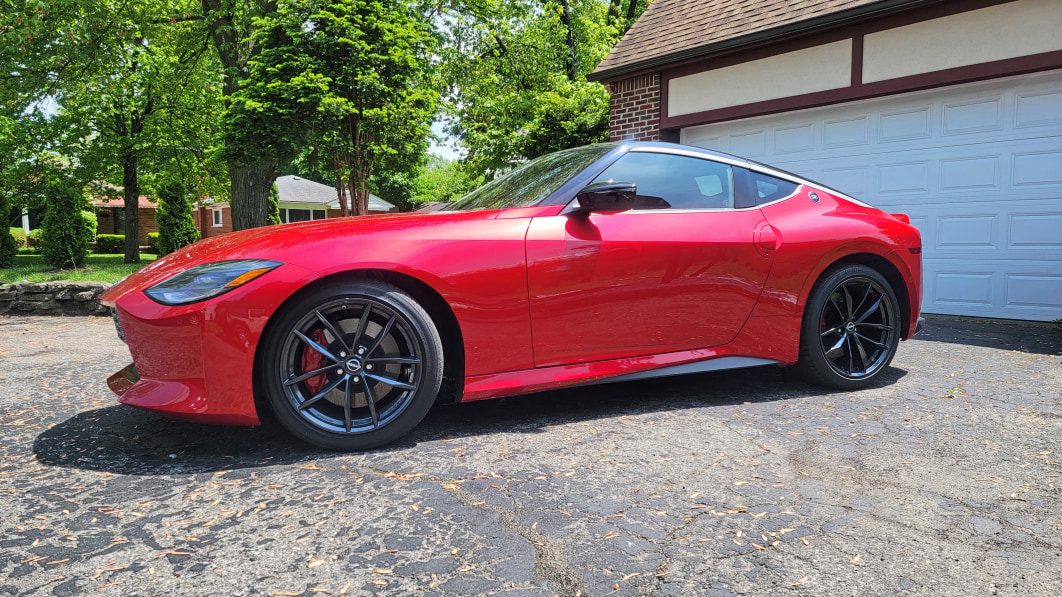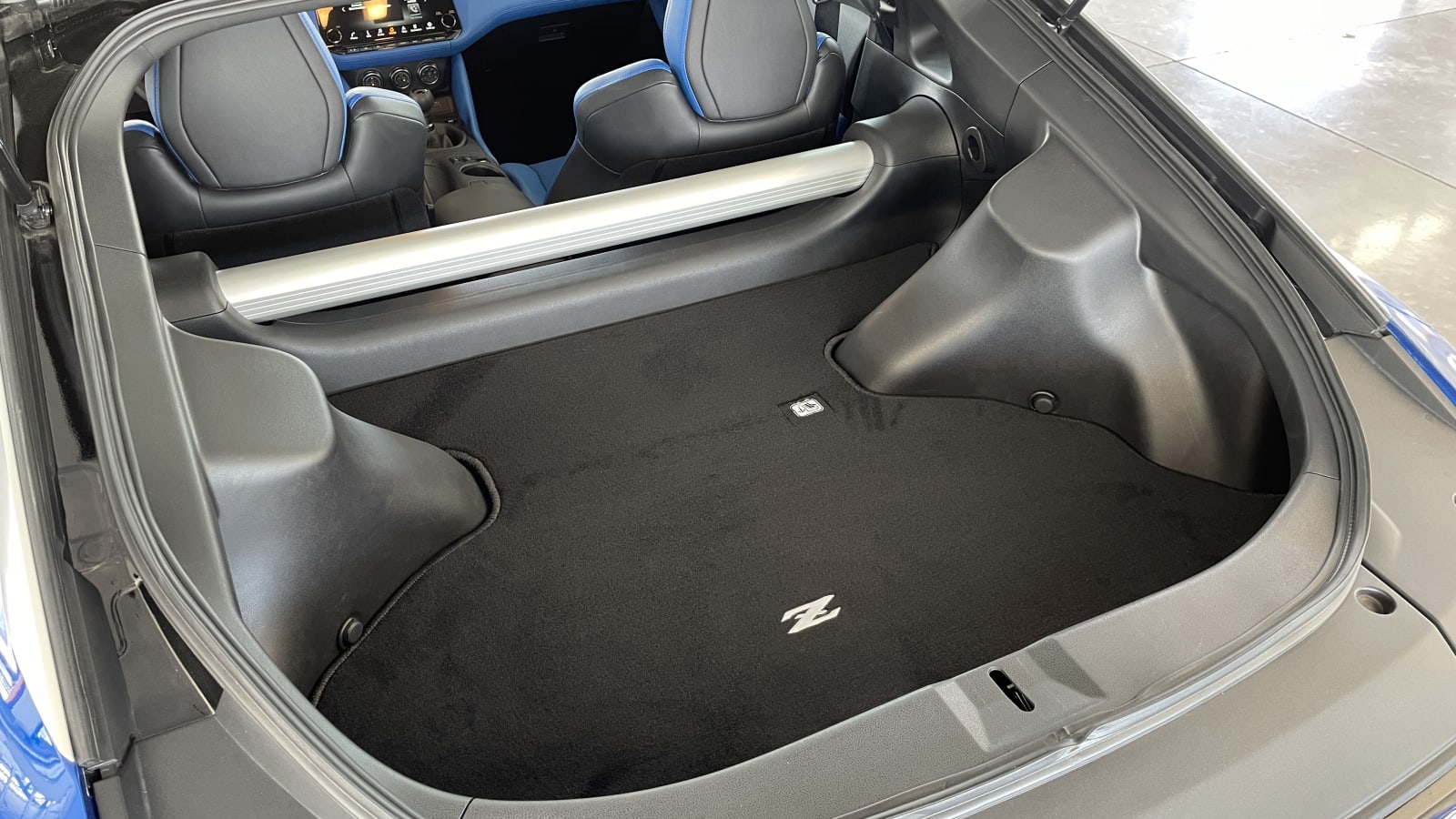2023 Nissan Z Road Test | A boomer re-jiggered for zoomers

One could credibly argue that I’d already made up my mind about the 2023 Nissan Z before the first example rolled off the production line. In short, Nissan set my expectations pretty high by pushing fast-forward on the 370Z’s impressively obstinate price creep — potentially too high to be met by a car that could be charitably described as “lovingly overhauled” rather than fundamentally redesigned. In a world of Supras and world-class pony cars, can a little more power once again make the Z relevant in the performance car discussion?
We’ll get to that, but let me talk about this particular Z, which is about as loaded as they come. It’s a Performance model, which means it was equipped with big brakes (+1.4 inches up front; +1.7 inches out back), a firmer suspension and a limited-slip differential not found on the standard Z. Since it was an automatic, we skip the 6MT’s rev-matching feature (downshift blips are standard on the AT, at least) and the stick’s carbon-fiber driveshaft.
If you’re familiar with the past two generations of Z cars and their Infiniti equivalents, plopping down in the driver’s seat of the new model will feel very familiar. Sure, the cabin’s been worked over from the ground up, but the conspicuously elevated seating position and high cowl are immediately familiar. It’s simultaneously (and somewhat incongruently) not as upright nor as cockpit-like as the Supra’s cabin, though the latter does feel more upscale.
In the process of packing for a day on the road with Fairlady, I confirmed yet another carry-over element: The Z’s cargo area still sucks. Its meaty rear suspension towers still intrude significantly, and even though the bracing between them was moved forward from its original location in the 350Z, there’s still virtually no room to work with back there. A well-stocked backpack will take up most of the available space. This is definitely a day-trip vehicle, not a long-haul tourer. If you plan to go solo, at least you can use the passenger seat and footwell as extra luggage room. None of the similarities are at all surprising, of course. Sure, the Z may be new, but it’s still based on the outgoing car, and Nissan did not go out of its way to pretend otherwise.
Prior to its redesign, I would have told you the Z needed nothing but better interior materials and an overhauled infotainment system — two things for which the 370Z was woefully desperate. But that’s not all we got. Nissan also kicked the old 3.7-liter naturally aspirated V6 to the curb in favor of a modern, 400-horsepower 3.0-liter mill with a pair of turbochargers slapped onto it. New to the Z but a known quantity in its own right, it should be the star of the show. Going in, I was a bit apprehensive.
I hate to be that guy, but what I most appreciated about the 370Z was the rev-happy V6 and relatively lightweight chassis. Tech and turbochargers — two things the 370Z lacked — come with mass. While Nissan managed to avoid price creep with the outgoing Z, curb weight creep was definitely a thing. Over the course of more than a decade in service, the 370Z added nearly 200 pounds of bloat. That’s particularly annoying in this case because the 370Z was a product of the early Great Recession era, when reducing curb weights still topped many manufacturers’ priority lists.
You may not remember, but the 2009 370Z was actually lighter than the 2008 350Z, but Nissan managed to give back those weight management improvements over the course of its lifecycle, turning that advantage into a deficit. Now it’s a point of continuity; this automatic checks in at 3,606 pounds — 200 pounds more than the 3.0-liter Supra and just 150 pounds shy of the Chevy Camaro SS and Mustang GT. I hate to be the “you could have had a V8” guy, so how about this: You could have had a V8, two more seats and a proper trunk. Yeah, I’m using “proper trunk” to describe the virtues of a Camaro. Ponder that.
But then you look at them, and there’s really no contest. The Z has a throwback elegance that the Mustang reaches for and the Camaro can’t even comprehend. That dash of old-school glamour really works for Nissan’s little two-door. It both asserts itself as one of the most affordable nostalgic motoring shapes and calls into question just exactly what Toyota’s designers were going for with the Supra. And let’s not be quick to write the Supra off to the constraints imposed by its BMW chassis.
Toyota may have been hamstrung by BMW’s hardpoints, but at least its engineers had, you know, a budget. The new Z’s spec sheet reads like the checklist of a skunkworks team with nothing but pocket lint and an enthusiastic engineer’s can-do attitude. Now, I can’t say for certain that the specter of a new stick-shift Z was enough to scare Toyota into throwing the a manual transmission into the Supra, but I’m saying it anyway. If a Toyota product planner would like to make a compelling case otherwise, my inbox is always open.
But for all the manual bruhaha, this particular Z doesn’t have one, and frankly this automatic’s only so-so. Rev-match shifts from a torque converter automatic were pretty cool when the 370Z was introduced for 2009. Today, that’s pretty much expected from anything with a “Sport” option on its drive mode dial. To make matters worse, this Z was an early prototype build. Tugs on the left paddle only commanded downshifts maybe 60-70% of the time, and more than once I found myself reaching for third or second gear from fifth or sixth only to land in fourth with my foot already down, confusing both the transmission computer and myself in equal measure.
But when it worked, it worked, and despite everything you know about turbocharged engines, the Z’s six is absolutely intoxicating near the top end of the rev range. It sounds great, hits like a hammer and manages to retain some of the high-strung character that made the 370Z so charming but without making a chore of day-to-day driving. The Supra by contrast is a bit more earnest — like a puppy, it’s cute when called for but can be tiring after a long slog through rush hour traffic.
Fortunately, neither the Supra nor the new Z will take an unwanted dump on your expensive new rug. The list of satisfying Japanese sports cars is one longer this year than it was in 2021. Even if the Z’s greatest contribution to the sports car scene is arguably pressuring Toyota into doing right by its enthusiasts, we’re better off for it.
Related video:







